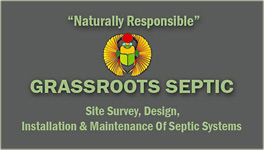 |
|
Improved Environment & Health Protection
Over the last 20 years there has been an increasing realization that many on-site systems were designed to dispose of sewage, rather than to treat and disperse it. Although a system may have functioned without evidence of sewage coming to the surface, it was possible that effluent may have been contaminating the environment through the groundwater.
As development increases and more homes are built in rural subdivisions, environmental impacts and the potential for contamination of drinking water increases. With this comes a demand from the public for safe systems, as well as recognition by local governments that on-site systems are an integral part of a long-term waste management strategy. Modern systems are designed to treat the effluent fully, disperse it with little or no impact to the environment, and have a long, effective life.
Your correctly designed and installed system has ensured your commitment to your environment.
How does my septic system work?Some 25% of Canadians treat their wastewater with a septic system. A septic system treats your wastewater on your own property, and releases the treated effluent back into the groundwater. A properly functioning septic system receives your household’s wastewater and treats it to a safe level before returning it to the groundwater system. A conventional septic system is composed of a septic tank and a soil filter, also called a leaching bed or drain field.
The septic tank separates liquids from solids and helps to break down some of the organic matter in wastewater. Partially treated wastewater from the septic tank flows into the drain field. The drain field is typically a network of perforated plastic pipes. The leaching bed is a soil filter that uses natural processes to treat wastewater from the septic tank. The septic tank and leaching bed must be professionally installed to ensure correct and safe operation.
How do I know if there might be a problem with my septic system?Warning signs that there may be a problem with your septic system include the following:
- The ground around your septic tank or drain field is soggy or spongy to walk on.
- Sewage odours are noticeable after a rainfall.
- Gray or black liquids are surfacing in your yard or backing up through the fixtures in your house.
- Toilets, showers, and sinks are backing up or taking longer than usual to drain.
Why might My Septic System be Failing?A properly maintained septic system will last for years. However, there are a number of reasons why a septic system may fail:
- Improper Maintenance – Septic systems do require periodic maintenance from a qualified professional. Your septic system designer should have provided you with a maintenance plan outline which you should refer to. It is important to keep a record of all maintenance.
- Overloading the System – Your septic system is designed to operate around the daily needs of your household, which would have been identified in the design and build of your system. A sudden, dramatic increase in water usage can overload the system and field and cause backup.
- Contaminating the System – Septic systems rely on bacteria to break down the waste material, and it is therefore important not to poison these microorganisms. Certain materials should never be put down a drain or toilet. Paints, solvents, thinners, and common household chemicals, if put down a drain or toilet, will adversely affect your septic system.
Repairing My SystemA properly maintained septic system should provide years of worry-free use. However, should you experience a problem with your system, it is important to immediately contact a certified professional to protect your health and the environment.
Repairs can range from pumping out your septic tank to repairing a broken tank, replacing the tank, or replacing the drain field
Do’s & Don'ts of using your systemMaintenance Suggestions - What to do
- Know the location of your system. Sketches and photographs can be invaluable. Keep maintenance records as well.
- Make sure all access points for the system are easily accessible. Do not place pools, decks, sheds or plant trees/gardens on system components as this restricts access for maintenance and monitoring.
- Never park or drive vehicles or equipment over any part of the system. System components are not built to withstand vehicle loads.
- Do not allow large animals or any animals that may compact the soil or dig in it on the field.
- Divert surface water (e.g. roof drains) away from the system.
- Never connect water treatment equipment backwash into the on-site system. These systems are not designed to accept the quantity or quality of such waste.
- Don’t water the grass on the dispersal area. Don’t compact snow on top of the dispersal area. Ensure the dispersal area is exposed to sunlight.
- Use liquid, not powder, detergent.
- Quickly fix leaking toilets and fixtures.
- Never put leftover cooking grease or food down the drain.
- Do not use a garburator.
- Never use drain-cleaning chemicals. They kill the beneficial bacteria in the system and can cause malfunctions.
- Do not dump waste from an R.V. into the system. Volume and chemicals can cause malfunctions.
- Never dump paint, solvents, or other chemicals down the drain and limit the amount of cleaning products.
Only flush human waste and toilet paper. Do not flush cigarette butts, coffee grounds, cat litter, feminine hygiene products, paper towel, hair, condoms, etc.
- Do not use septic additives such as bacteria or enzymes. At best they are a waste of money, at worst they can damage the system. Sufficient bacteria is found in human waste.
- Have the system checked on a regular basis (1-2 years for simple systems) by an ROWP Maintenance Provider. More frequent schedules may be required for more complex systems but this will be listed in the Operating & Maintenance Plan for the system.
- Avoid entertaining large groups for more than half a day. Each system is designed based on the expected number of occupants in the home. More than this can quickly overwhelm the system leading to sewage backing up into the home or onto the lawn. Sometimes this damage can be permanent. If you must entertain a large group, have the septic tank emptied the day before and allow the party to fill the tank.
- Spread laundry out during the week. This can help avoid overwhelming the system.
- Conserve water. If too much water flows into the septic tank wastewater is pushed into the dispersal area before the settling and separating process can occur. Clogged pipes and worse can result. Reduce your shower time and use a water-efficient shower head. Replace your toilets with modern water-saving models.
- Educate everyone who uses your system about use and care.
Owner ResponsibilitiesSection 10 of the Sewerage System Regulation requires that the owner of a sewerage system:
- Must ensure that a sewerage system on the owner’s land is maintained in accordance with the operation and maintenance plan provided by the system planner.
- Must keep records of all maintenance service performed on the system.
- Must ensure that he or she follows all other requirements under the SSR and with local government by-laws.
If you are:
the owner of a home with an on-site system… you are responsible for its maintenance and safe operation. An improperly used or maintained system can pose a hazard to public health and the environment. This is the homeowner’s responsibility to prevent or correct.
having problems with your system… have the problem diagnosed by an Authorized Person and repaired. Many typical problems can be corrected with some maintenance work, but if ignored, can result in the need for a replacement system.
renovating or adding on to your home… you may need to have the system upgraded to accommodate it. This can be determined by a Registered Onsite Wastewater Practitioner Private Inspector or a Planner capable of assessing existing systems if a Private Inspector is not available.
building a new home… you will need to have a new system planned and installed. Contact Registered Onsite Wastewater Practitioner Planners and Installers to assist.
buying or selling a house or do not know the details of the existing system… have the system inspected by a Registered Onsite Wastewater Practitioner Private Inspector.

| HOME PAGE • SERVICES • RESOURCES • YOUR SYSTEM |
GRASSROOTS SEPTIC
T. 250.397.2250 • C. 250.644.8763 • E. peter@grassrootsseptic.com
Box 22, Eagle Creek BC, V0K 1L0